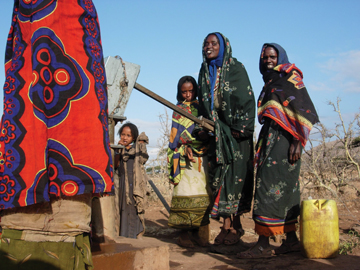The theme for this year’s World Water Day—“water and jobs”— is intended to draw attention to the often invisible role of water in creating and supporting jobs, and how better water supplies could create better jobs. Nowhere is this more applicable than for women’s access to water, especially in rural areas.
Official statistics indicate that 79 percent of economically active women in the world’s least developed countries report agriculture as their primary activity. However, these statistics overlook millions more women who produce food for their families and the market from homestead gardens—often an important source of family income and nutrition.
Control over water is essential for productive agriculture, and this is becoming even more important in the context of climate change. Yet when women’s agricultural roles are under-recognized, are women’s water needs in agriculture being met?
While there has been welcome attention to women’s lack of control over land, there has been far less attention to the limitations on women’s control over water—and the implications for economic productivity. Recent research indicates that a host of technological, economic, and cultural factors limits women’s ability to irrigate. A study of market-based dissemination of treadle pumps in Kenya and Tanzania, for example, found that women were less likely to receive information about the technology, often lacked the funds to purchase pumps, and many of the pumps were too heavy for women to operate, or considered culturally inappropriate because they exposed women’s legs. Women also face limited opportunities to participate meaningfully in both community and household decision making over water allocation and use. For example, in many contexts, only land owners are considered members of water user associations; women are effectively excluded because they are less likely to own land or have land titled in their name. Decisions on the distribution of water are then made without representing women’s specific needs and priorities.
The invisibility of women’s work in agriculture and water stems in part from the tendency to assign women’s roles to a domestic or reproductive domain—work not seen as productive. This artificial distinction between productive and reproductive work, however, masks the economic contributions that women make, and excuses underinvestment in women’s access to water. For example, financial institutions in Ethiopia will not provide credit for homestead wells because the wells are not considered economically productive investments, reflecting a failure to appreciate the contribution of women’s unpaid work (domestic chores and homestead gardening or livestock keeping) to household livelihoods.
What data there is on women’s access to water focuses on domestic uses, which is certainly vital. But domestic water supply systems often limit the amount of water per household, and may even prohibit using the water for gardens or livestock. Multiple-use systems that plan for both domestic use and a range of other basic productive uses can help overcome this problem by making water available for food production and reducing the time women spend on water collection and other household chores. This can free their time for other income-earning activities, or enable girls to go to school in preparation for the labor market. Recognizing women’s water-related activities as jobs—whether paid or unpaid—would also help, as these activities could then be linked to formal information services such as agricultural extension and diverse sources of financing.
If women had better access to water control and technologies that met their needs it would benefit not only the women themselves, but also their households and communities. Making this happen requires doing a better job of asking what people—women as well as men—want in terms of technologies, financing, and decision making about water supplies, and involving them in solutions. This year’s World Water Day theme of water and jobs can help to make this happen, but only if we think of “jobs” as including all activities that use water, whether paid or unpaid.
For more on IFPRI’s water-related research, see more information about a gender and water workshop series, the IFPRI water policy research program, and other latest publications related to Water.







